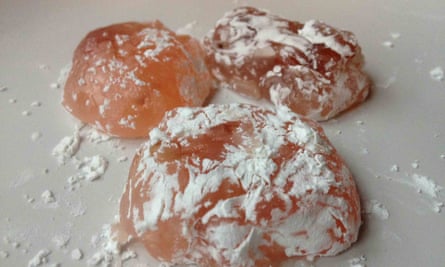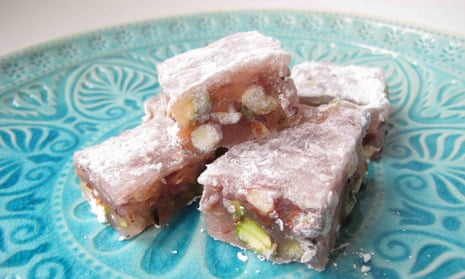Are there any more evocative words in the English language than Turkish delight? Full of Eastern promise, as the classic Fry’s advertisement has it, and lightly dusted with Narnian magic. Which child could fail, on reading of Edmund’s greedy pleasure in the White Witch’s enchanting gift – “Sweet and light to the very centre” – to wish for a round box of Turkish delight for themselves, “tied with a green silk ribbon”? Frankly, I’d sell my soul for less.
Unfortunately, the contents are often likely to disappoint. Not that I don’t have a soft spot for Fry’s bouncy rose-flavoured jelly, or indeed the sadly discontinued Cadbury Roses version (sorry, sometimes this column throws up nasty shocks) but both are a long way from the pillow-soft, delicately aromatic confections originally intended to soothe sore throats and, perhaps, to sweeten long, dull days in the Topkapi harem.
On a recent trip to Istanbul, I was in seventh heaven. Lokum was everywhere I looked: great colourful pyramids of the stuff, flavoured with melon and saffron, studded with hazelnuts and rolled in musky rose petals. While everyone else took a box back “for the office”, I took it upon myself to eat the lot, “for research purposes”. And once I’d licked the last morsels of sugar from its corners, it was time to do that research. Here are the (extremely sweet) fruits.
Setting agent

This is a bone of contention here. It is traditionally set with starch, with the mixture slowly thickened over heat in much the same way as a white sauce, but modern recipes often speed things up by adding gelatin for more reliable results. Little wonder given that, according to the Frenchman Pretextat-Lecomte, who observed the process in the late 19th century, the secret of authentic lokum lies in stirring the mixture “in the same direction, and without interruption” for “approximately two hours”. (Two men, he noted, took turns.)
Unfortunately, I do not have two men at my disposal, I have a dog, and he’s a liability around pans of boiling sugar, so I’m resigned to stirring Gaitri Pagrach Chandra’s version, from her book Sugar and Spice, for 50 minutes without help. This makes me feel very sorry for myself, as well as giving me a blister, so halfway through I pretend I haven’t seen the bit where she tells me that “stirring without interruption in the same direction is crucial for a good result” and switch hands. It seems OK, though; the end result has a soft, smooth texture, but a pleasingly firm set.
This cannot be said of my attempt at Claudia Roden’s recipe from A New Book of Middle Eastern Food, which is cooked for three hours, although she generously allows “stirring as often as is possible”, which in practice means in the breaks between trying to clean molten sugar from the rest of the kitchen. Even my largest Le Creuset is struggling with nearly 3kg of sugar products. The instructions direct me to cook the mixture until, when a blob is placed between the fingertips, and these are drawn apart, it makes gummed threads. The heat of these blobs perhaps leads me to imagine threads before they were really there, but suffice to say, my lokum never quite sets firm enough to cut. I clearly do not have her patience.
Marcus Wareing uses a combination of gelatin and cornflour in his book Nutmeg & Custard, as does Arto der Haroutunian in his classic Turkish Cookbook. Too late I realise, as I’m attempting to dissolve 15 sheets of gelatin in 120ml water, that he must mean the powdered stuff. Consequently, though his is wonderfully chewy, it also comes with strands of partially melted gelatin, which is not a good thing.
Wareing’s, meanwhile, has a satisfyingly bouncy texture not unlike a bar of Fry’s, but quite different from the stuff I brought back from Istanbul. It strikes me, with sinking heart, that starch-only is clearly the authentic way to go. That said, Roden’s pulverised mastic, a resin also used to make a deliciously stringy ice-cream, and various other desserts throughout the region, not only gives hers a pleasant piney flavour, but a slight elasticity that I rather like. It’s definitely optional (and you’ll probably need to buy it online unless you too are lucky enough to live near a lot of Turks) but do give it a try.
The sugar

The main ingredient of Turkish delight is, of course, refined sugar. There’s no getting away from it. Well, you could use grape molasses, as in the older confection, kesmer, but according to the Oxford Companion to Sugar and Sweets, the “substitution of sugar syrup … made it possible to develop a sweetmeat with a new range of sophisticated and expensive flavourings, such as musk and rose, which the distinctive flavour taste of the grape juice would have overpowered”. Honey is sometimes added, but white sugar is the norm. Roden uses a proportion of glucose as well, presumably as a charm against the possibility of three bags of sugar crystallising on to the base of the pan. It’s expensive, however, and Pagrach Chandra’s cream of tartar promises to do the same thing rather more cheaply.
The flavouring

This is largely up to you; I like Wareing and Der Haroutunian’s rose water, no doubt for its nostalgia value, and I imagine I’d like Roden’s orange-blossom water, too, if I’d added it more slowly; a commonly available brand is so powerful that even half her suggested 3 tbsp tastes like shower gel. Mea culpa.
Der Haroutunian also adds vanilla, which is another possibility, as is the lemon juice in many recipes (which will supply extra protection against the dreaded crystallisation). Just try and add whatever it is to taste. Colouring is entirely optional, though given Turkish delight is hardly a health food to start with, I have no scruples about jazzing it up.
Additions

Pagrach Chandra eschews flavourings and colourings in favour of a whole range of toasted nuts: pistachios, hazels and pine, which contrast pleasingly with the soft lokum. Der Haroutunian goes for pistachios and Roden suggests almonds, but, as with flavourings, use whichever you happen to like (or none at all, if you prefer).
Finishing
Make sure you pour the hot Turkish delight into a well-greased, floured tray to set; I cannot stress this enough. Do not, as Wareing suggests, pour it straight on to cling film, or you will have to cut this off, and it is hard to slice wobbly jelly without also cutting off a fingertip.
Once sliced, you can roll it in desiccated coconut, as Pagrach Chandra does, Wareing’s melted chocolate, or a mixture of cornflour and icing sugar, like the Turkish delight I remember from childhood; or indeed you could go for the finely chopped nuts or petals that so impressed me in Istanbul’s Spice Bazaar.
Whatever you do, don’t spoil your hard work by storing these in an airtight container; they’ll sweat horribly. Instead, keep them in a well ventilated box at room temperature. Or, you know, just eat them.
(Makes about 36 4cm cubes)
500g granulated sugar
125g cornflour, plus 2 tbsp to dust
1/2 tsp cream of tartar
4 mastic crystals, crushed (optional)
1/2 tsp rose water or other flavouring
A few drops of food colouring (optional)
100g pistachios, roughly chopped
100g almonds, roughly chopped
2 tbsp icing sugar
Grease a small-rimmed baking tray generously (mine is about 18 x 23cm).
Put the sugar into a large, heavy-based pan with 600ml water and the cream of tartar and bring to the boil, stirring to dissolve the sugar.
Meanwhile, put the cornflour into a medium pan with 200ml water over a medium-low heat and whisk into a smooth paste. Then whisk it into the pan with the sugar until smooth – if it suddenly comes together in lumps, don’t panic, keep whisking.
Swap to a wooden spoon and stir, as continuously as possible, to bring it to the boil, then turn down the heat and stir for about 50 minutes until it is thick and the spoon leaves clean lines in the mixture. Have a bowl of cold water by the hob.
Start testing; it’s done when a small teaspoon, cooled in the water, can be pressed into a firm but squishy lump. Stir in the flavourings, including the mastic, if using, and colouring and taste (remembering to let it cool slightly first!) and cook for a minute or so more, stirring. Mix in the nuts.
Pour into the tray, flatten the top and leave to set at room temperature, then mix the icing sugar and remaining cornflour. Cut into cubes and toss to coat, then store in an open box at room temperature.
Turkish delight or harem horror? If, like Edmund, you love it, which flavour’s your favourite, and does Fry’s count? And what else can I do with my little bag of mastic tears?

Comments (…)
Sign in or create your Guardian account to join the discussion